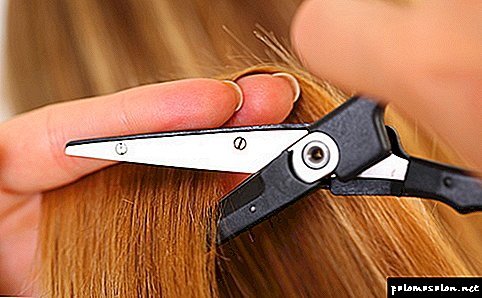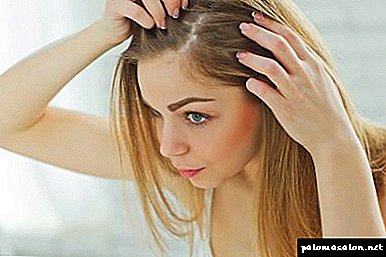The range of false hair is very diverse.
Tress divide:
- In form: straight and curly.
- Length: 45 to 75 cm.
- By material: synthetic and natural.
- By color: a huge variety of color palette.
- By type of attachment: on hairpins (clips), on elastic bands, on a fishing line.
As for the shape, it is better to have both sets (straight and curled). It is not so expensive, and thermal effects on synthetic or natural overhead strands quickly lead them into a state of disrepair. With proper care, false hair will last about 3 years.
Choosing False Hair
One of the most important issues in the selection of tress - is the selection of color. The color palette of synthetic strands is huge, much more than natural false hair, so you shouldn’t rush into acquiring it. But the selection of strands of a lighter or darker shade than the natural one, will allow to create the effect of highlighting or coloring.
Natural patch strands are a great alternative to hair extensions, which severely damage your hair and require special expensive care. However, when choosing strands you need to take into account the type of hair (for European thick hair, strands of the same structure are selected). When choosing false hair, it is important to pay attention to the amount of strands, that is, their thickness (how many grams of hair you acquire). If the finished tresses are not very voluminous, then you can bond them together, thereby achieving greater volume.
What to look for when choosing a false hair?
There are the following differences between the artificial strands on the clips:
- Is long
- Colors and shades
- Texture (straight, wavy),
- Material (natural, artificial).
Before you start choosing the strands you need on hairpins, you need to determine the final result that you want to see after their attachment. If you want to increase the length, then you need to make the right measurements, according to which the choice is made. To do this, take a centimeter tape and determine the distance from the top of the ear to the desired length.
 In addition, it is worth considering that for a more lush and long hairstyle you need to focus not on the number of strands, but on their weight. The rule that applies in this case, the longer the false hair on the hairpins, the more you need strands to get a beautiful and voluminous head of hair in the end.
In addition, it is worth considering that for a more lush and long hairstyle you need to focus not on the number of strands, but on their weight. The rule that applies in this case, the longer the false hair on the hairpins, the more you need strands to get a beautiful and voluminous head of hair in the end.
Another point that should be paid attention to when choosing is color. When ordering strands on the Internet, remember about the inaccurate color rendition of the monitor, which can be mistaken for several tones, so for a more accurate selection it is better to see the strand live and compare it with your hair color.
Important is the material from which the applied tressy. Owners of thin and sparse hair are encouraged to choose natural, because they are easier to mix with their own hair and the differences are less noticeable to others. In addition, natural strands you can easily curl, dye and pull ironing, their service life is much longer than artificial.
How to attach hair with hairpins
The main goal that needs to be achieved while fixing the overhead tresses is that the end result should be as close as possible to the natural one, without revealing to the outsider the secrets of the lush dust in the form of prominent strips of tresses among his own hair.
Step-by-step instructions for correct fastening of the strands on hairpins:
It is necessary to start the process from the back of the head, securing the rest of the pile on top.

It is necessary to disassemble the hair into horizontal strands about two centimeters thick from each other, so that the next layer overlaps the previous one well. It is not necessary to strive to make the parting equal, because it does not affect the final result.

Separating a sufficient amount of your own hair so that the strands with the clips hold well, you can start fixing from the central part, thus avoiding the hairpin sticking out in the side of the head.

After fixing the first strip, you can safely move to the second layer, dividing the remaining hair in such a way that there is enough space for all the existing tresses on the hairpins.

During attachment, you need to firmly press the clip, catching the strands with your fingers, and deeply plunging the teeth of the hairpin into the pile of your own hair.

Turning to the lining of the upper layers, it is necessary to comb your own hair, in order to keep tresses more tightly and not to move while you are wearing, you can also sprinkle them with a little varnish.
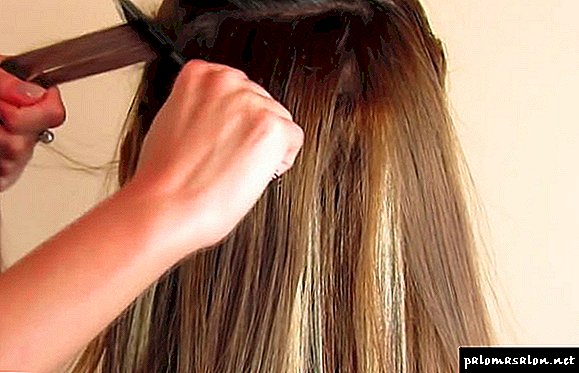
Side strands should not be attached too close to the face, retreating 2-3 cm.
If you are the owner of light curls, then in this case, for better masking of tresses after the end of the process of attachment, the last layer of hair at the roots should be better combed.

Blondes are recommended to paint tress together with the strand itself into the necessary tone so that the artificial hair on tresses blends better with natural ones.
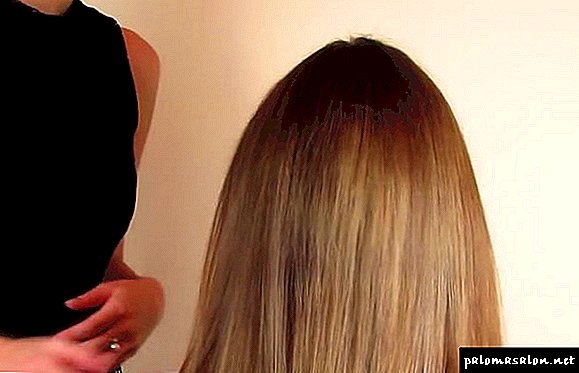
Experts recommend attaching clips not at the roots themselves, but retreating a few millimeters, thereby better hooking and more tightly grabbing their own strands. It is easy to remove the overhead strands, tackling each barrette in layers and sorting out the hairstyle step by step.
Care for clip-on hair
In the process of using strands of hair on the hairpins are contaminated with almost the same intensity as their own, so they need special care. Before you begin the washing process, you need to determine what material the tresses are made of. To do this, you will need matches and a few hairs from a mound, which must be set on fire, and if during burning they emit a peculiar smell similar to the smell of a gummy pig, then the material is natural. If they smolder, melt and do not smell, then the material is artificial.
Tresses on hairpins from natural material should be washed in warm (not hot) water, with shampoo and balsam, while the comb can only be used after the strands have dried, in the process of washing you need to smooth the hair with your fingers. After washing, the tresses are laid out on a soft cloth and allowed to dry, the use of a hair dryer for drying is not recommended in order to avoid damage to the hair structure, thus prolonging their service life.
The hair on the clips made of artificial material is washed in warm water with the addition of bread soda at the rate of 1 liter of water two teaspoons and a mild shampoo that is whipped into a lush foam. First, clean the hairpin itself, and then strand with fingers or sponges.
Artificial hair tangles faster than natural hair, so during washing it is not recommended to knead and squeeze them. After the procedure of washing, the strands are blotted with a towel, treated with an antiseptic, spread on the fabric until it is completely dry, and only after that they can be combed.
It is necessary to store tresses in a dust-free place, over time the strands lose their glossy shine, so they must be periodically treated with special means to restore the natural structure.
False hair with clips: “for” and “against”
Positive aspects of using the accessory:
- you will be able to take them off and dress them yourself at will,
- subject to various styling and drying procedures,
- create chic hairstyles
- they do not require constant care from hairdressers, and therefore are an economical option,
- with proper care, the service life is more than three years.
Minuses to consider:
- some girls experienced a feeling of heaviness when wearing tresses,
- with the wrong attachment, the strand can fall off in a crowded place, delivering a lot of trouble to the hostess,
- when attaching strands, your own hair must be combed against growth, which can damage the structure.
How to attach hair with hairpins in the form of one wide strand
Such a strand has an average width of 25 cm and this length accounts for 5 pins. The length of the false hair can be any, the structure is also chosen individually - straight, wavy or curly.

The figure shows the line along which a single wide strand is attached. The line runs just above the top edge of the ear.
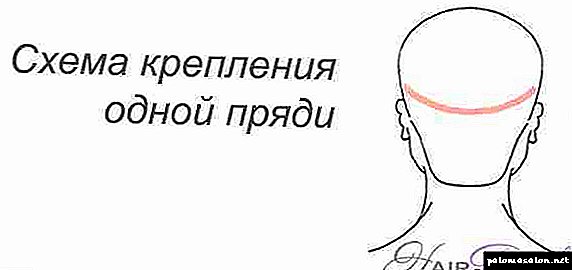
Make a parting along this line, collect all the hair above the parting on the top of the head and fix it with a clip.
Attach a strand to the parting and at the place of attachment of each barrette, make a small tail.

Extend all the clamps on the tape, revealing them. Attach the ribbon to the parting and snap each clip in turn over the corresponding tail.

After all the hairpins have closed, comb the patch strand with a comb with sparse teeth, and dissolve the hair from the crown.
How to fasten hair on hairpins from a set of strands of different widths
False hair in a set of strands of different widths are attached using the same technology, with the only difference that you will need to make a parting for each individual strand. As a rule, there are 3 wide strands on the back of the head and 4 narrow locks for the temporal zones.

The figure shows all the lines along which the strands are attached (3 wide and 4 narrow).

You need to start with the lower occipital strand, it is the shortest of the wide ones.

Next is fastened next strand width, and then fasten the widest.
Now we define the place and make a parting for small strands on the temples. Each of them is mounted on one hairpin, which means that it will be necessary to make a tail on the parting.

- In the case when the hair parting is not in the center, but deeply on one side, then only one patch can be fixed on the temporal zone, below the parting.
- After you have dismissed your hair, shake your head and let your hair flow freely. If somewhere in the hairstyle you can see the fastening of the patch strand, you will need to remove this strand and attach it just below, under a thicker layer of your hair.
- If the patch of natural hair, then it can be curled or straightened to fit your hairstyle. It is better to leave the synthetic strand in the state in which you bought it (curls or straight hair), and twist or straighten your hair, respectively.
What are the tress
First of all, you should not confuse hair extensions on tresses, which is called “cold”, and the false straps themselves on hairpins, which are rather an alternative to this procedure, and not its kind.
The latter are the same hair that is used for building in beauty salons, but focused on home use and not involving prolonged wearing.

Artificial strands are mounted on a flat clip, which is not visible from the front because of their density, and can form a row of 5 pins, which is equal to the distance from ear to ear along the back of the head. At the same time, tresses can be formed in several rows at once, usually so as to close the occipital zone.
The materials used for them can be both natural and artificial, resistant to heat treatment and chemical compounds: thus, the overhead strands can be washed, dyed, curled and straightened.

If we talk about salon hair extensions on tresses, then this is the most safe option creating thick and long hair, because it does not imply exposure to high temperatures, as well as the use of glue, resin and similar materials. According to this method, the master braids thin internal braids along transverse partings, to which the artificial strands are fastened with the help of sewing. On top of that, only hair extensions on tresses allows for a natural basal volume.

It should be said that in the photo and salon extension, and home use of the strands look absolutely identical, while in comparison with other methods of changing the hairstyle, the hair does not break up into separate sections, because distributed over the tape evenly.
Thus, with their help, you can not only change the length of the hair, but also increase the densitythat will require fewer strands. True, as with any kind of extension, there is a negative point: looking beautiful in statics - in a photo or in collected hairstyles - in dynamics artificial strands can be noticeable in strong winds, and also if you run your fingers through the hair.
Editorial Board
If you want to improve the condition of your hair, special attention should be paid to shampoos that you use.
A frightening figure - in 97% of shampoos of famous brands are substances that poison our body. The main components, due to which all the troubles on the labels are designated as sodium lauryl sulfate, sodium laureth sulfate, coco sulfate. These chemicals destroy the structure of the hair, the hair becomes brittle, lose elasticity and strength, the color fades. But the worst thing is that this stuff gets into the liver, heart, lungs, accumulates in the organs and can cause cancer.
We advise you to abandon the use of funds in which these substances are located. Recently, experts of our editorial staff conducted an analysis of sulfate-free shampoos, where the first place was taken by funds from the company Mulsan Cosmetic. The only manufacturer of all-natural cosmetics. All products are manufactured under strict quality control and certification systems.
We recommend to visit the official online store mulsan.ru. If you doubt the naturalness of your cosmetics, check the expiration date, it should not exceed one year of storage.
What material is better
Hair extension tress - procedure not the cheapestand its cost is determined by the material from which they are made. Experts divide them into 2 main groups: these are artificial hair from thermofibre and natural.

- ArtificialFor the creation of which kanekalon is most often used: resistant to deformation, not melting under the influence of irons and ploek, which does not change the structure of chemical compounds. Such strands have a dazzling shine, more noticeable than that of natural hair, so they are not suitable for owners of dull dry curls - the difference in structure will be visible to the naked eye. However, there are no restrictions for a photo: you can always add or dim the glow in the editor. A significant disadvantage of this material is that it is rather heavy.
- Natural The hairs on the hairpins can have a different structure: mostly Slavic, European and African. This makes it possible, with a probability of almost 100%, to choose the ideal option for oneself that will not reveal the “secret” of the origin of length or density, not only in the photo, but also in life. Such strands are slightly lighter, have a less pronounced luster, and are also devoid of electrification. They are confused almost the same as Kanekalon, if longer than 30 cm.

Of course, artificial hair is much cheaper than natural: in a number of online stores you can buy 21 hairpins with 60 cm length curls for 1200-1400 rubles, which allows you to set up experiments almost infinitely. Natural European strands are cheaper to find 4000 rubles for 50 cm (and this is only 7-8 pins) quite difficult.
Regardless of what material you choose, it is important to choose the right shade.
Professionals advise personally try on favorite strand, but this is not possible if we are talking about an online store. Here you should contact an online consultant who will need your photo in natural light without color correction.
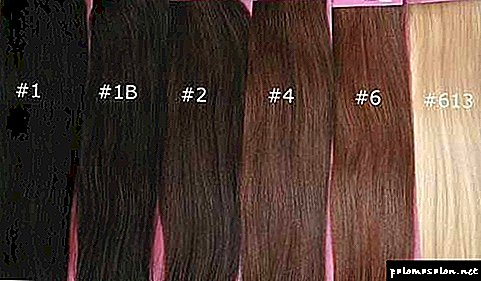
How to mount tressy
And so, the product is selected, the bag (or box) is in your hands, the color is perfect, but the most important and difficult question for most girls appears: how to attach them? The answer depends on what you want to get from the finished hairstyle.

- If you are only interested in increasing the density, 2-3 tapes with barrettes are enough, which will be located on the occipital and parietal zones alone.
- If you want long hair, while not showing the fact that they are artificial, the strands must be fixed on the transverse partings above each other at a distance of 1-1.5 cm. do not create large gaps. In this case, of course, you will need a lot of tapes.
- In addition, the fact of the hairstyle itself is also important: when wearing loose hair, tresses are evenly distributed over the entire head area. For the collected - localized at the collection point: for example, at the base of the tail. If the side parting is assumed with the hairstyle collected, the main part of the tress will be in the zone where there is a greater amount of own hair.
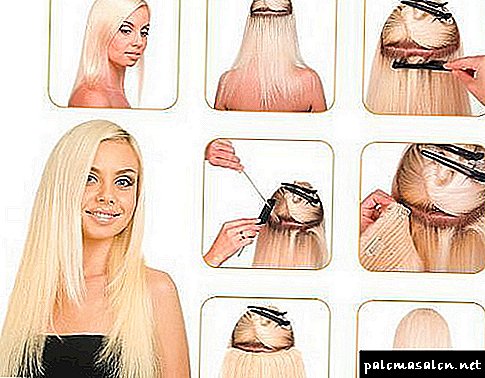
As for the fixation technology itself, there is at least 2 most convenient waysthat are advised by professionals. However, before trying them out in person, you should familiarize yourself with step-by-step photos and training videos that will reveal all the nuances of this complicated procedure. Especially important are the photos of the algorithm for working with the schemes described above: this will allow you to correctly identify all zones and directions.

- To begin, comb through all the linen of hair, as well as artificial strands. Using a comb with a knob, make a side parting on the back of the head, separating a very thin bottom layer. Catch the rest of the weight with a clip so as not to interfere.
- Protrude the bottom layer from the outside, concentrating the pile at the root - about 2-3 cm. Pick up the ribbon, the width of which will be equal to the width of this layer, then fix the hairpins clearly parallel. Pay attention to the fact that the thickness of the layer of your own hair must be such that the neck under it does not shine through, otherwise the hairpins will not be able to catch quality. Using this technique, create partings. every 1-1.5 cm upward, fixing the rest of the tress. The top layer (facial) should not be too thick to "lose" the line of cutting native hair in artificial density.
- It is possible to attach tresses differently, in approximately the same way that is used for cold buildup: you also make a parting at the bottom, then separate the side strand from it and braid a horizontal braid from it, picking up a piece of hair from each bottom layer for each link. The teeth of the barrette are inserted into the links of the braid, and it is clamped.
This method is much more reliable and, in addition, adds basal volume, but it is extremely difficult to execute it yourself from behind — dexterity is required.
Rules for the care of artificial hair
In the photo, both Kanekalon and natural strands look equally attractive, especially if they are made by a manufacturer who wants to profitably sell their material. In reality, to make artificial hair look no less beautiful (or at least neat), you need to follow a number of rules:
- For combing it is recommended to use brushes with metal teeth, however classical natural nap in mixture with plastic is allowed. Natural curly hair can be disassembled only with your fingers.
- Before washing the strands, they must be combed, having unraveled all the knocked-out sections, while doing so from the tips. Then dissolve the shampoo cap in a basin with warm (not hot!) Water, put the hair in there for 10 minutes, run your hands over it several times and take it out. Rinse with cold water. Balms and masks are not required.
- It is desirable to dry without a hair dryer, spreading out on towels, in no case putting it on the battery or heater.
- It is worth noting that not all artificial strands allow them to be screwed onto hot tongs or straightened: some manufacturers use very cheap fiber melted from high temperatures. In order not to be afraid for this moment, look for the mark "thermo".

In conclusion, it should be said that artificial strands, like natural hair, allow haircuts, so do not worry if the store did not have the length you need - it is never too late to shorten them.
Encyclopedia of False Hair
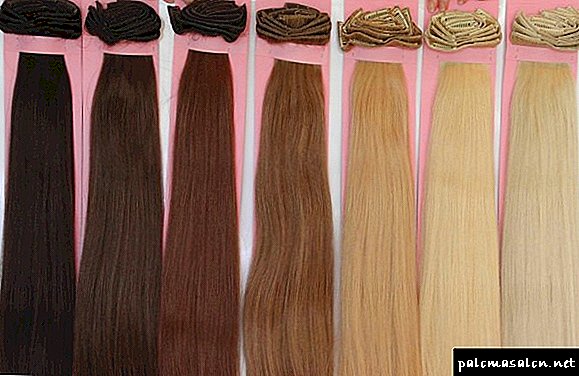
A wide palette of shades allows you to choose strands as close as possible to the color of natural hair
In the modern world, false curls on hairpins are more popular than ever among girls. With the help of them, owners of sparse and short hair will be able at any time to enjoy long, thick head of hair. Using the overhead strands, you can create a variety of hairstyles and daily change your image.
Likbez overhead strands

Photo of the use of overhead strands
Few people know what is called false hair. Such strands have a simple name - tresses and are curls connected in the root area with the help of a special firmware, on which are located one or several hairpins for attachment to native hair. Most of the time, such as posters are used as professional hair clips, which are very simple and convenient to use.

Postizhernye clips have a silicone layer for a more secure fit
Note! If you are the owner of wavy or curly strands - be sure to choose the tresses on the hairpins with a silicone layer. Such clips allow you to securely fix the overhead strands on curly hair.
Tress very easy to use, and if necessary they can be removed and folded into the package. With the help of tress, you can give the head of hair only volume and thickness, and you can only increase the length of the curls. If you buy false strands of natural hair, you can easily change their color at the same time with their native curls, simply by treating with the same coloring agent.
Tip! Give preference to tresses of natural hair or good quality canicalon, as they can be curled, dyed and straightened with a curling iron.
Advantages and disadvantages

Tresses made of natural material allow you to create a magnificent volumetric hairstyle
Overhead strands have proven to be a convenient and fast way to transform their appearance. They have both pros and cons.
Spit straight straight hair
Comb the hair on one side, weave a braid using the fishtail technique diagonally from the right temple, each time grabbing a little more hair from the side. When the braid is almost completely finished, the weaving technique changes a little. There will need a secret rezinochki to match the hair: two extreme strands are taken and sealed with an elastic band, then turned inside. This must be repeated several times, depending on the length of the hair. This technique of fastening the ends makes it easy to pull the strands to give volume to the braid. Pull strands need to start from the bottom to 1 cm, smoothly moving to the back of the head. At the back of the head, we stretch the strands more actively, this will allow the spit to be given volume on the head.
This everyday hairstyle is easy, with the help of several barrettes or hairpins, it transforms into an evening hairstyle. Just twist arbitrarily the end of the braid and fix it under the nape from the weaving side. Get a great rose from the hair.
If you split the hair in half and weave the same braids "mirror", you get a completely different hairstyle. Having left loose strands in the zone of bangs and temples, you can curl them beautifully and place them over braids, fixing them with invisible marks.
Another option hairstyles, which is suitable for "publication". The hairs of the temporal part rise to the faith and are fixed with hairpins, keeping them raised at the roots. Further weaving with elastic bands begins from the temporal zone (take the two extreme strands, fasten with an elastic band and turn inside out). So we repeat 3-4 times to the edge of hair growth on the back of the head, while pulling for the volume strands. We finish the weaving of the ends with the usual oblique "spikelet", and also stretch the strands to create the effect of "careless braid".
Evening styling with false hair
We divide the hair into three zones: the temporal and occipital. The temporal zones curl and fasten at the top of the invisible, lifting at the roots, leaving the forehead open. The hair on the back of the head is formed into bundles and we pull down the strands. Each "harness" is collected in a bundle and fixed on the back of the head in the form of a "basket". Leaving a few loose strands in different areas of the hairstyle, you can enhance the effect of negligence. The hairstyle is decorated with decorative hairpins or beads for hair.
What types are there?
There are 4 types of hair: Russian, European, Asian and Indian. They are also divided by length, color and shade, natural material or artificial, texture (wavy or straight).
Russians. Top quality and expensive. Such strands can be colored, straightened and curled. They are not processed and sold in their natural form.
European and Indian. Have the same structure. Such false hairs (with barrettes) are inferior in quality to Russians, which is why their price is cheaper. Special process of processing serves long use.
Asian. Of all kinds of the cheapest and low-quality product. They are made in dark shades, and to the touch - hard fiber. Differ in small service life.
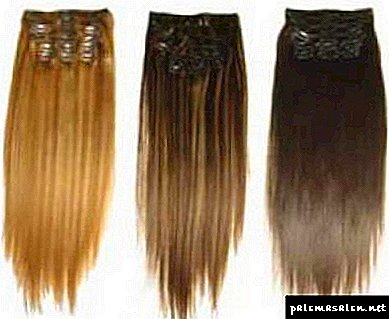
How to choose?
Before you choose, carefully consider the original result. If you increase the length, make the right measurements (centimeter from the top of the ear to the tips). The longer the curls, the more strands for the desired volume will be needed.
Colored hair on hairpins choose live. To accurately select the tone and compare with your hair color.
If the hair is sparse and thin - it is recommended to select natural strands. In this case, the differences are not so noticeable.
How to attach hair with hairpins: step by step instructions
In order to easily attach the strands of your own, you need to know some rules. This procedure is simple and does not take much time.
How to attach hair with hairpins? Consider in detail this procedure:
- Before fixing, wash and dry their hair. Make a little fleece at the base (roots).
- Long strands cling to the back of the head. Short curls - on the crown and near the temples. If you purchase a kit, there is a manual.
- In the horizontal direction at the back of the head divide the hair into small strands.
- Apply tressy on the intended place and secure the hairpin.
- From above cover with the hair and continue, moving on to the crown.
- At the temple between the overhead strands make a small indent. This will help create a natural look.
- At the top of the cling tressy last. For a neat appearance, do it around the circumference.
After all the strands are carefully fixed, you can do the styling or hairstyle.

Hairstyles with false hair on hairpins
Further. Due to the fact that the overhead strands lend themselves to a variety of styling, the range of possibilities for the production of hairstyles increases.
- Horns. Split your hair evenly in half. Each part is twisted into a bundle and rolled up in the form of horns and fixed invisible. Original look, if the artificial strands are multi-colored.
- Spit. Gather their curls at the back of the head in a tight tail. Allocate the central part and fix the patch curls (you can take color). The upper part of the tress covered with native curls and braid braid. They can be different: a fish tail, a Russian or French braid, with complex openwork weaving, etc.
- Ponytail. Own curls are collected high on the back of the head in a tight tail. From above to an elastic band fix tressa. To hide the junction, allocate a small strand and wrapped around the beginning of the tail (fixed invisible).
- Straight curls. The most simple and everyday hairstyle. Gather hair at the crown. Fix a few narrow strands from the bottom and top spread all the hair.
Hairstyles with false hair (on hairpins) look natural and very original. By allocating a small amount of time, you can create elegant and unusual creations.
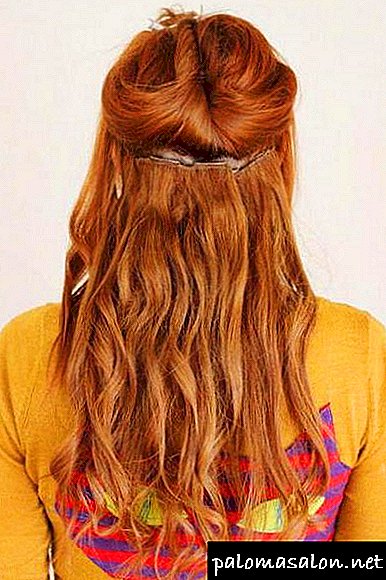
How to care?
Proper combing. Use a brush with a soft bristle or a special comb for hair extensions. Gently begin with the tips and gradually move to the crown. Experts recommend using a spray for moisturizing.
When laying applied thermal protection. The maximum heating of the hair dryer (ironing) - 160 degrees.
The washing up. Use shampoos for dry hair, not recommended for oily. Carefully unravel curls before washing. Conditioners should contain collagen or keratin. When washing it is forbidden to rub the curls against each other. When wet, they do not comb, wait until complete drying (about 7 hours).
For coloring natural curls take sparing paints or tint (shampoo). It is well amenable to coloring curls of bright colors.
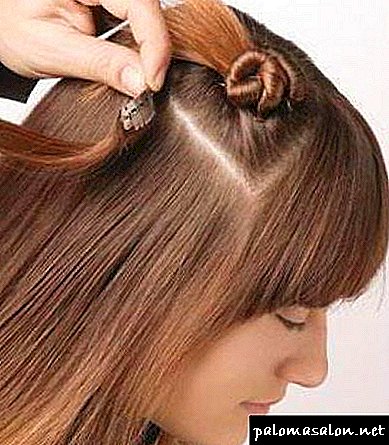
Coloring
For self-dyeing, it is recommended to take tresses from natural fibers. Artificial strands will not give the desired result.
- Pre-small curl experimentally stained. If the result is satisfied, proceed to complete painting.
- Wash off and dry.
- Prepare the paint and do the processing of the strands along the entire length.
- Coloring time - 10-15 minutes. less than recommended in the instructions.
- Curls are washed under running water, put a balm.
The whole procedure is not much different from dyeing your hair.
How to cheat?
Natural hair wrap curling give way much easier than artificial. How it's done?
- The tool is heated to 160 degrees.
- A thin curl is separated and moistened with a small amount of water.
- Curls are heated, but not more than 30 seconds.
- The tongs are carefully removed, and the lock in the form of a ringlet is fixed invisible until it cools completely.
- Manipulation is done with all the strands.
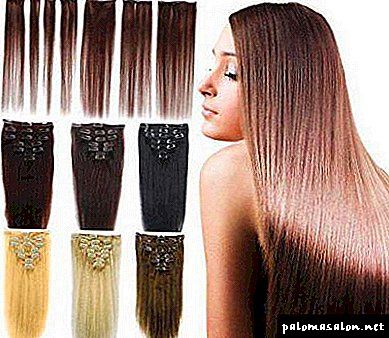
Advantages and disadvantages
- at the expense of curls increases the length and volume,
- You can do a variety of hairstyles that are designed even for long hair,
- False hair can curl, dye, align. Produce a variety of manipulations
- with proper care will last a long time,
- You can remove the length at any time.
- at first you will have difficulty in fixing (how to fix hair on hairpins, discussed above). For the desired result, you need to practice,
- quickly lose their appearance, if you apply frequent painting and styling.

Where can one buy? How much?
Where can I buy hair with hairpins? Get them in specialized stores for wigs. Also now there is a huge number of online stores where the price will be cheaper. The disadvantage of such a purchase is the inability to compare the tone of the strands.
How much does hair on hairpins cost? Prices are varied, depending on whether - natural material or artificial. Also repelled from the length. The average price per 100 g of natural strands will be about 10 thousand rubles. Artificial cost will be much cheaper - about 2 thousand rubles.
This article discusses how to attach hair to hairpins. Having mastered these easy manipulations, in the shortest possible time you can increase the length, add volume and density for a variety of hairstyles.
Selection rules
Before you attach the overhead strands, determine the final result. For example, you want long curls. Then you need to measure the required length of the neck before buying a strand. A lot of important to know what will be the hairstyle in the end. If you are going to curl your own hair, then you need to wear fake hair in the form of curls.Curly long strands look very beautiful!
And, of course, the color of its strands and the order of the clips should ideally be the same.
Strands differ among themselves:
- long
- color,
- material of manufacture (natural or artificial),
- form of production (straight and curls).
 If you are going to create a voluminous hairstyle, then keep in mind that the weight of many strands can cause discomfort
If you are going to create a voluminous hairstyle, then keep in mind that the weight of many strands can cause discomfort
It is better to buy products in stores, and not through the Internet, so as not to be mistaken when choosing a color. So you will have the opportunity to attach a curl to your head and compare shades.
The material is no less important. If your own hair is thin, then it will be significantly different from artificial, so it is recommended to wear only natural hair. Mixing, they seem imperceptible. In addition, their service life is longer.
 Another advantage of natural strands is the ability to curl, straighten, dye
Another advantage of natural strands is the ability to curl, straighten, dye
How to attach false hair with hairpins
After purchasing the desired order you need to familiarize yourself with the rules for their use. It is more difficult to attach hair on hairpins, so it is better to entrust it to another person. Well, if you have no choice, follow these steps.
- In order to properly attach hair with hairpins, pre-comb your own hair.
- On the upper points of the ears, separate the strands and stab them from the top, so as not to interfere.
- Next you need to take a strand, undo the clips and fasten the hair on the hairpins. If your own hair is very thin, then it is better to make a close-up and fix it with a styling varnish. So hair cling hairpins will be easier.
 It is necessary to fasten false hair on hairpins neatly but firmly so that the clips themselves are tightly pressed
It is necessary to fasten false hair on hairpins neatly but firmly so that the clips themselves are tightly pressed
- Next, we perform a new horizontal parting about 2 centimeters above the first one and lower the separated curls onto the attached strands.
- Now you can again attach the hair with hairpins. The wide strand is designed for the back of the head.
- Narrow strands are designed for temporal areas of the head.
- After you have managed to attach false hair, comb them gently.
 Now create the desired hairstyle
Now create the desired hairstyle
Strands on tresses
There are several technologies to increase curls, and one of the first was the pressing.
For her need strands on tresses. Attach stresses can be in two ways.
- A braid is tied around the head and you need to fix the hair on the tresses by sewing.
- In another way, the tresses are glued on a special adhesive tape in the root zone.
You can wear short hair tress. This allows you to increase the density and drastically change the length.
 If you attach a tress to the clip, you can take it off and put it on when you want
If you attach a tress to the clip, you can take it off and put it on when you want
Care of the straps is simple.
 Wash them with regular shampoo
Wash them with regular shampoo
Drying should occur naturally. To do this, simply lay out the strands on the towel. For natural hair, you need to use special care products to maintain the natural shine.
 And, of course, before you remove the curls in the box, you need to gently comb them
And, of course, before you remove the curls in the box, you need to gently comb them
Keeping and dressing hair with hairpins is not that difficult. The main thing is to follow the instructions.
Overhead strands, tress on hairpins
Tress on hairpins are strands of curls with hairpins-scallops, which they attach to natural hair. The kit includes 6 strands. With their help, you will add a large amount of hair, add length, without resorting to the help of stylists and without needing a subsequent correction.
It is best to pick up the presses on the hairpins of natural hair, rather than artificial. When choosing, pay attention to the mount: barrettes should be small, almost imperceptible, so that during use they do not stand out.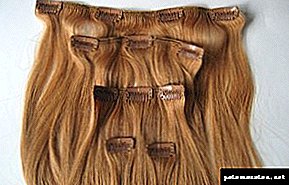
The color of the false hair should coincide as much as possible with your own, unless, of course, you want to make the effect of highlighting or coloring with their help.
It’s not so easy to find fake strands that match your natural hair color. But even here there is a solution: the hair strands can be tinted to your tone, the main thing is that their pad is natural.
Overhead tressy hairpins are attached easily, you can do it yourself.
How to fix the strands on the clips
- Comb your hair the entire length.
- Make a parting at the bottom of the head, the rest of the hair should be fixed with a barrette at the top.
- Make a pile at the place of fastening clips and fix hairspray.
- Unzip all the clips. To make it easier to attach the straps, start with the middle one, and then go to the side. Secure the clips in this position.
- Step back a little, shift the curls and attach the strand above.
- It is the same with the other strands: moving to the crown, making transverse partings at the temples, fasten the strands of curls.

When you have attached strands, you can start creating a fashionable image: weave pigtails, ears and much more, it all depends on your imagination.
Overhead curls: as the tress on the backs of the mount at home, 5.0 out of 5 based on 3 ratings


